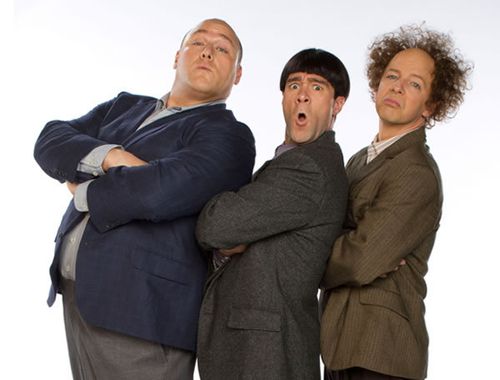Zombos Says: Good
There's screwball comedy, there's slapstick, there's farce, and then there's The Three Stooges, who took the Depression's stark reality and slapped it silly until it cried "Uncle!" Funny how times haven't changed much: with us a thumbnail length's distance from another Depression this time around, Moe, Larry, and Curly are back, bending reality into stark silliness and absurd mayhem once again. (Note to Roger Ebert: As any fan of the comedy trio will tell you, the key point to remember when watching The Three Stooges, in order to appreciate their low-brow antics, is this: there is no point; just go with it. Knowing this would have helped you find the humor.)
This time around it's Chris Diamantapoulos as Moe, Will Sasso as Curly, and Sean Hayes as Larry. The big question most Stooges fans will want to know the answer to is "Do these newbies have the vaudeville timing? Do they have that endearing rat-a-tat-tat delivery combining physical skirmishing with verbal insouciance down pat?
The anwer is a resounding well,somewhat.
The familiar routines are here but they lack the kinetic smoothness honed from performing the motions a thousand times, like the original Stooges had done on stage. That's not to say they don't work successfully, but there are times they don't seem natural to Moe, Larry, and Curly's beings: I wondered why Curly was doing that antic, or Moe was doing this antic in certain scenes that didn't really warrant that particular aberrant behavior. Hayes's Larry doesn't fully fit the original Larry's shoes, either. Larry Fine, the perennial receiver of Moe Howard's short end of the stick, was a master of passive-aggressive duplicity. Hayes takes a different approach, rendering Larry less passive-aggressive and more dull-witted. At least his Bozo-styled hairdo lends itself as a successful running gag throughout.
Another challenge the Farelley Brothers (not to be confused with the Fratellis of The Goonies) needed to overcome in bringing the Stooges back to the big screen was the short subject movie length Moe Howard, Larry Fine, and Curly Howard (and eventually the shamefully underrated Shemp Howard) normally paraded their antics in. Forget the full-length movies, those came later and were written for juveniles (I mean the real ones) and didn't have Curly or Shemp as foils to energize the slapstick--although Joe Besser and Curly Joe weren't too shabby in their own right. Would all the eye-poking, face-slapping, and inappropriately handled construction hardware hold up past the half-hour mark?
The answer is why soitenly!
Creating a faux short subject approach, The Three Stooges hour and a half movie is broken into segments with titles, but the storyline's excessive cardboard sentimentality stifles throughout. For a moment I thought the Farelley Brothers had watched too many Little Rascals episodes and not enough Three Stooges shorts. (There are even two orphaned kids with Our Gang-sounding names, Peezer and Weezer.) Feelings never got in the way of The Three Stooges, unless they were the result of a badly aimed sledgehammer or a crowbar wedged up Curly's nose. Perhaps the biggest challenge of all was how to make the Stooges relevant again. Would making fun of rich people, beating up mean manly nuns (that would be Larry David as Sister Mary-Mengele), and watching babies peeing with deadly aim still be funny to watch?
The answer here is hell, yes!
In what is perhaps the closest realization of the essence of The Three Stooges's brand of carnage, a maternity ward's babies become surprisingly effective bio-weapons as the boys goes at each other. The timing is impeccable, the scene completely idiotic and hilarious because of its idiocy. Of course, using two hot irons as defibrollator paddles runs a close second. More could have been done, but there's enough physical comedy and wordplay here to initiate those unfamiliar with the Stooges's style of comedy.
The misstep in execution comes from the Farelleys resorting to retro-izing the Stooges world instead of forcing them to cope with the modern one. Using the hoary orphanage backstory, we see the Stooges as hastily abandoned orphans, watch as the nuns initial joy at finding the foundlings turns to fear as the boys grow into unsafe-to-be-around kids, and we're finally brought to present day when the orphanage must close due to their accident-prone behaviors forcing medical insurance coverage to be dropped and the orphanage to owe hundreds of thousands of dollars in payments.
Moe, Larry, and Curly embark on a journey to find the money. Having been sheltered in the orphanage all their lives, the outside world proves Facebook compared to their phone book approach. All those potentially sublime catastrophic encounters--an Apple Genius Bar or maybe even annoying sidewalk cell phone chatterers, are two that easily come to mind--aren't explored. The Farelley's play it safer by using a standard, but simplified, murder plot and a surprisingly witty meta-stooge scenario with a notable reality television show.
After kicking around in development for 10 years or so, The Three Stooges movie could probably have been written better. But if you go with the flow, you may be surprised and find yourself laughing without knowing why. And that's what The Three Stooges were all about.




Comments